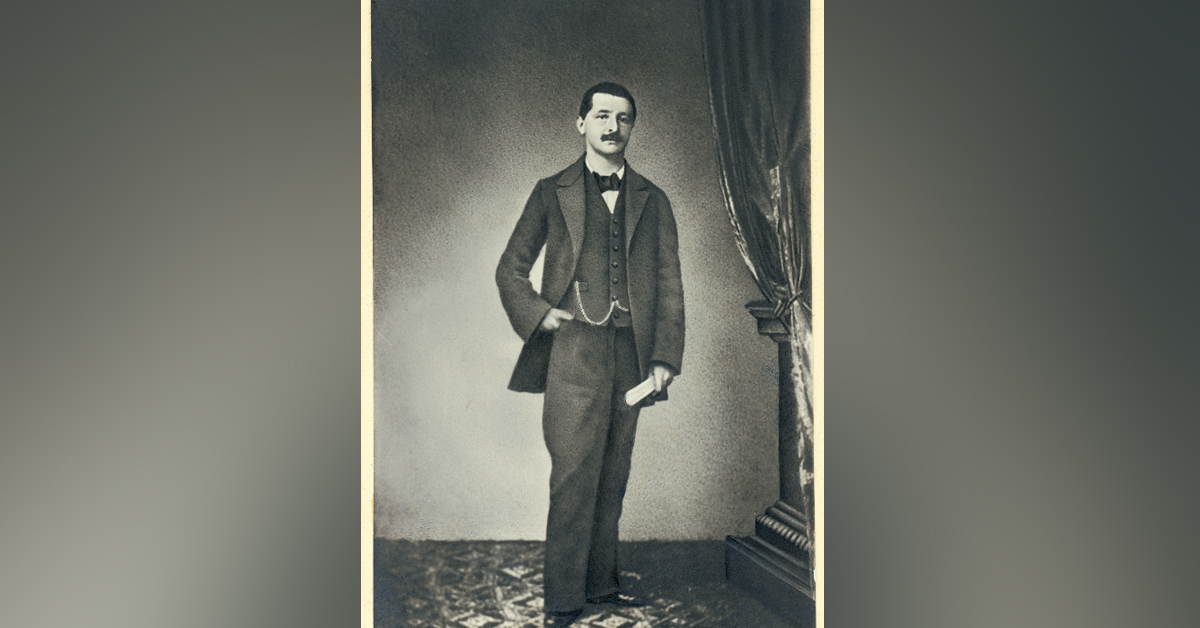
Anton Bruckner (1824-1896)
Mahler FoundationMahlerContemporariesAnton Bruckner (1824-1896)
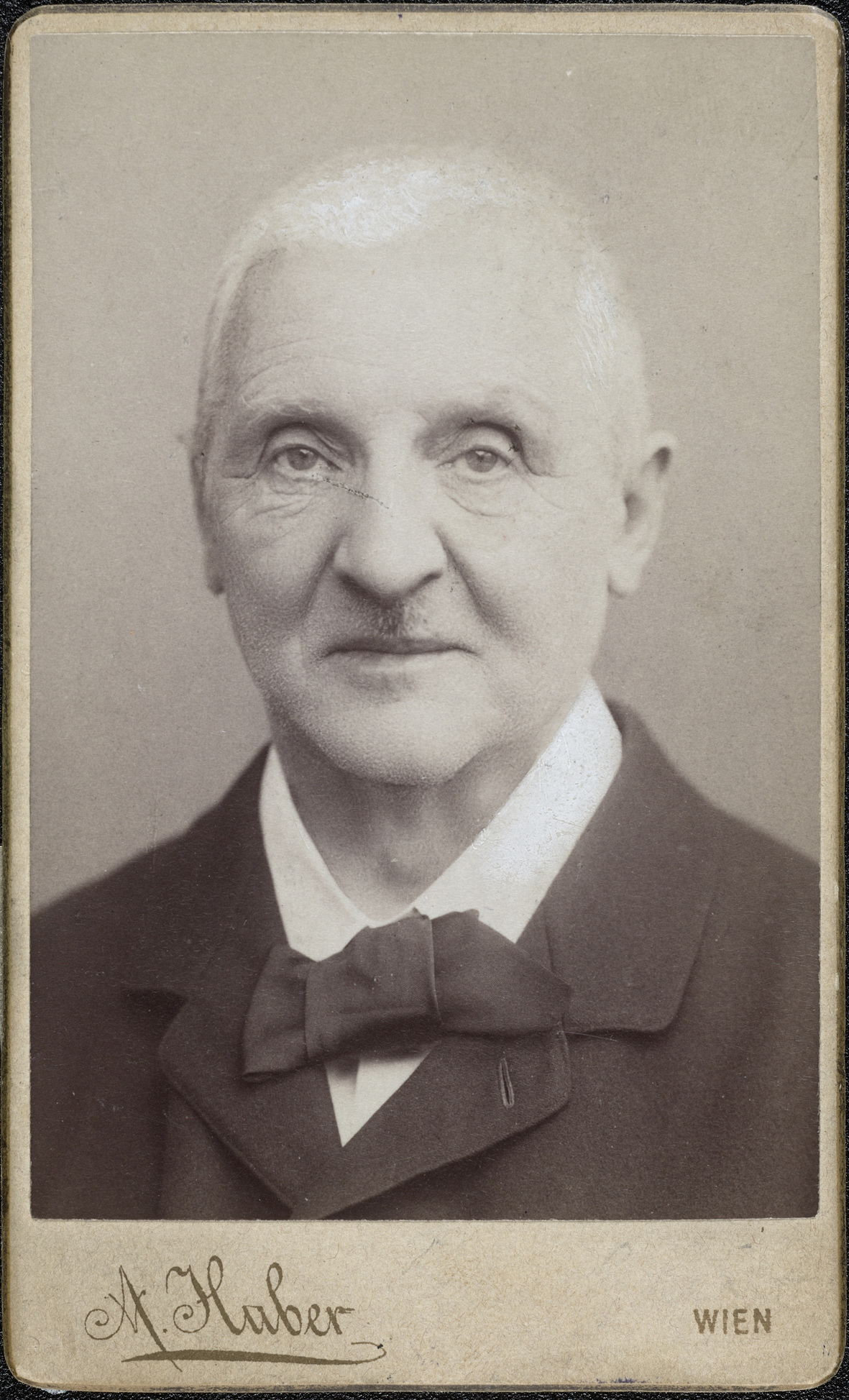
- Profession: Composer.
- Residences: Vienna.
- Relation to Mahler: Mahler had lessons from him at the Conservatory of Vienna. Mahler considered Bruckner as his precursor, for his compositions with dissonances, unprepared modulations and itinerant harmonies that helped define contemporary musical radicalism.
- Correspondence with Mahler: Yes.
- Born: 04-09-1824 Ansfelden, Austria.
- Died: 11-10-1896 In 1895 emperor Franz Josef I, Emperor (1830-1916) offered him free quarters in the Belvedere Palace. There, after a morning spent working on the Ninth Symphony (the finale is incomplete), Bruckner died on 11-10-1896. Aged 72.
- Buried: 00-00-0000 He is buried in the crypt of the monastery church at Sankt Florian, immediately below his favorite organ.
Anton Bruckner was an Austrian composer known for his symphonies, masses, and motets. The first are considered emblematic of the final stage of Austro-German Romanticism because of their rich harmonic language, strongly polyphonic character, and considerable length. Bruckner’s compositions helped to define contemporary musical radicalism, owing to their dissonances, unprepared modulations, and roving harmonies. Unlike other musical radicals, such as Richard Wagner or Hugo Wolf who fitted the enfant terrible mould, Bruckner showed extreme humility before other musicians, Wagner in particular.
This apparent dichotomy between Bruckner the man and Bruckner the composer hampers efforts to describe his life in a way that gives a straightforward context for his music. His works, the symphonies in particular, had detractors, most notably the influential Austrian critic Eduard Hanslick, and other supporters of Johannes Brahms (and detractors of Wagner), who pointed to their large size, use of repetition, and Bruckner’s propensity to revise many of his works, often with the assistance of colleagues, and his apparent indecision about which versions he preferred. On the other hand, Bruckner was greatly admired by subsequent composers, including his friend Gustav Mahler, who described him as “half simpleton, half God”.
Biography
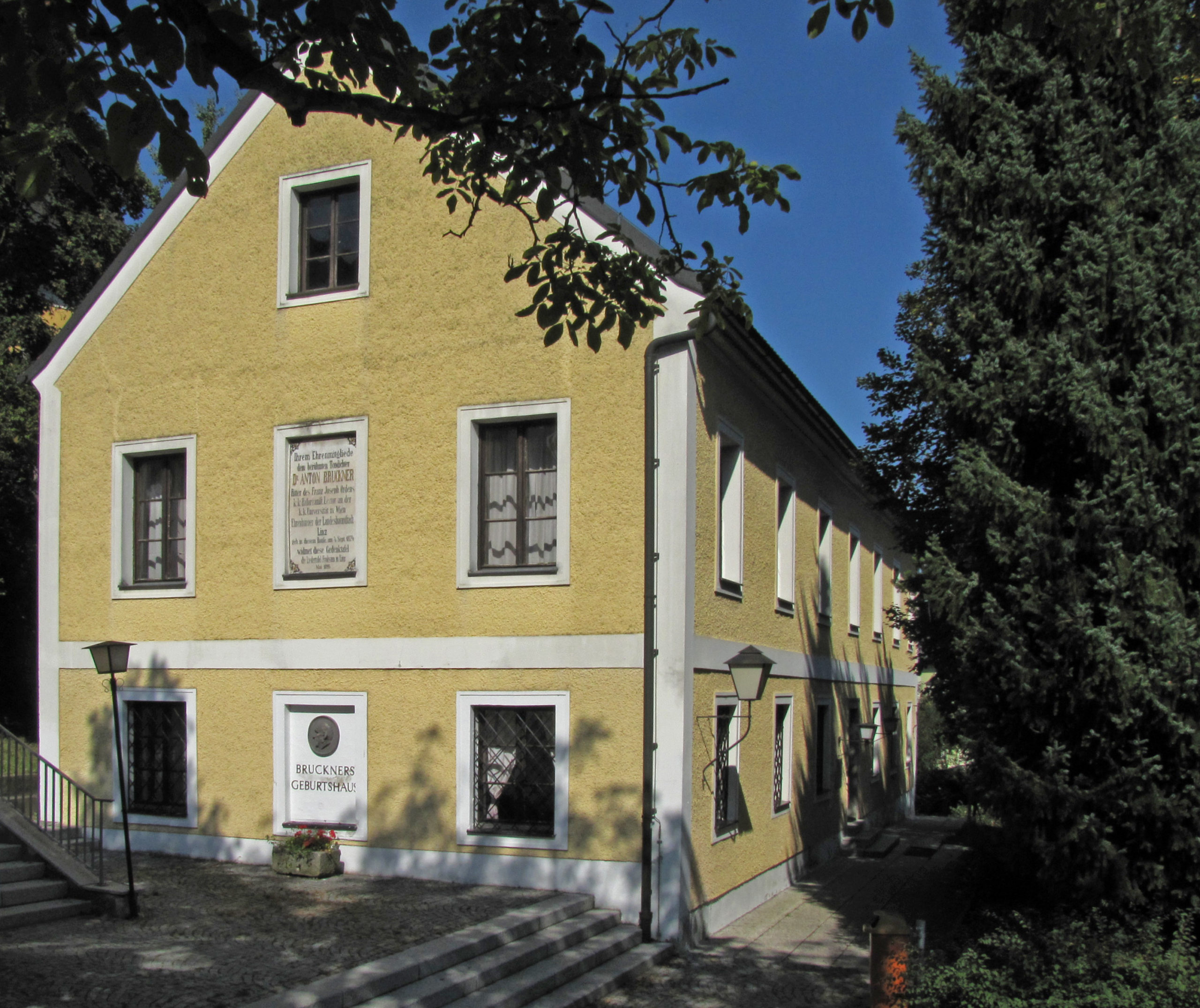
The birthhouse of Anton Bruckner (1824-1896) in Ansfelden.
Anton Bruckner was born in Ansfelden (then a village, now a suburb of Linz) on 4 September 1824. The ancestors of Bruckner’s family were farmers and craftsmen; their history can be traced to as far back as the 16th century. They lived near a bridge south of Sindelburg, which led to their being called “Pruckhner an der Pruckhen” (bridgers on the bridge). Bruckner’s grandfather was appointed schoolmaster in Ansfelden in 1776; this position was inherited by Bruckner’s father, Anton Bruckner senior in 1823. It was a poorly paid but well-respected position in the rural environment.
Music was a part of the school curriculum, and Bruckner’s father was his first music teacher. Bruckner learned to play the organ early as a child. He entered school when he was six, proved to be a hard-working student, and was promoted to upper class early. While studying, Bruckner also helped his father in teaching the other children.
After Bruckner received his confirmation in 1833, Bruckner’s father sent him to another school in Hörsching. The schoolmaster, Johann Baptist Weiß, was a music enthusiast and respected organist. Here, Bruckner completed his school education and learned to play the organ excellently. Around 1835 Bruckner wrote his first composition, a Pange lingua – one of the compositions which he revised at the end of his life. When his father became ill, Anton returned to Ansfelden to help him in his work.
Teacher’s education
Bruckner’s father died in 1837, when Bruckner was 13 years old. The teacher’s position and house were given to a successor, and Bruckner was sent to the Augustinian monastery in Sankt Florian to become a choirboy. In addition to choir practice, his education included violin and organ lessons. Bruckner was in awe of the monastery’s great organ, which was built during the late baroque era and rebuilt in 1837, and he sometimes played it during church services. Later, the organ was to be called the “Bruckner Organ”. Despite his musical abilities, Bruckner’s mother sent her son to a teaching seminar in Linz in 1841. After completing the seminar with an excellent grade, he was sent as a teacher’s assistant to a school in Windhaag. The living standards and pay were horrible, and Bruckner was constantly humiliated by his superior, teacher Franz Fuchs.
Despite the difficult situation, Bruckner never complained or rebelled; a belief of inferiority was to remain one of Bruckner’s main personal characteristics during his whole life. He would stay at Windhaag from age 17–19, teaching subjects that did not have to do with music. Prelate Michael Arneth noticed Bruckner’s bad situation in Windhaag and awarded him a teacher’s assistant position in the vicinity of the monastic town of Sankt Florian, sending him to Kronstorf an der Enns for two years. Here he would be able to have more of a part in musical activity.
The time in Kronstorf was a much happier one for Bruckner. Compared to the few works he wrote in Windhaag, the Kronstorf compositions from 1843-1845 show a significantly improved artistic ability, and finally the beginnings of what could be called “the Bruckner style”. Among the Kronstorf works is the vocal piece Asperges (WAB 4), which the young teacher’s assistant, out of line of his position, signed with “Anton Bruckner m.p.ria. Comp[onist]”. This has been interpreted as a lone early sign of Bruckner’s artistic ambitions. Otherwise, little is known of Bruckner’s life plans and intentions.
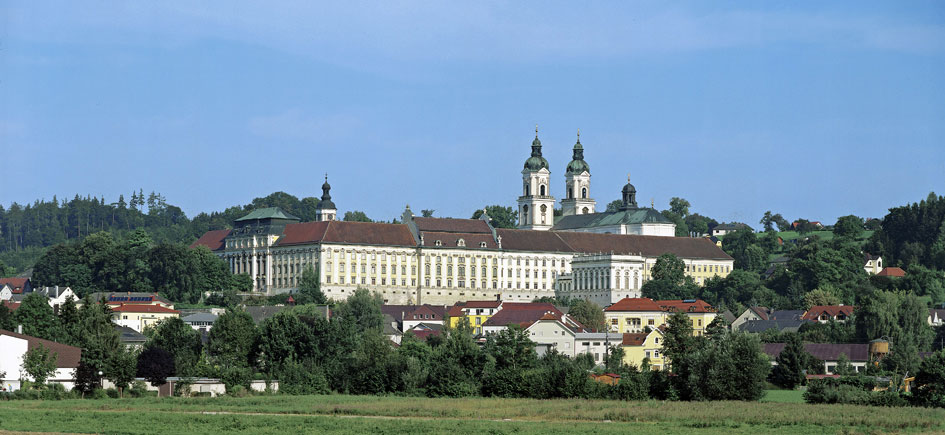
Priory in Sankt Florian where Anton Bruckner (1824-1896) lived on many occasions during his life.
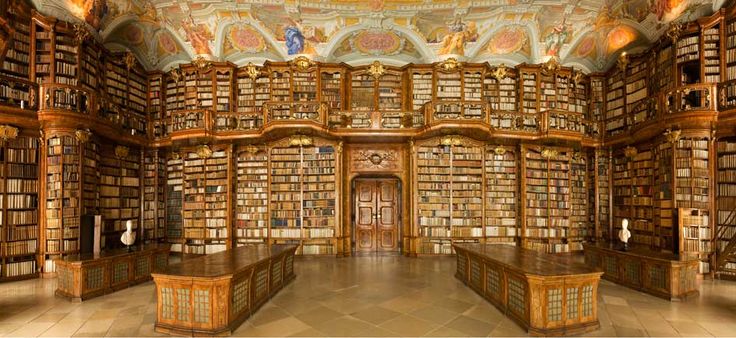
Anton Bruckner (1824-1896). Library in Sankt Florian’s Priory.
Organist in Sankt Florian
After the Kronstorf period, Bruckner returned to Sankt Florian in 1845, where, for the next 10 years, he would work as a teacher and an organist. In May 1845, Bruckner passed an examination, which allowed him to begin work as an assistant teacher in one of the village schools of Sankt Florian. He continued to improve his education by taking further courses, passing an examination giving him the permission to also teach in higher education institutes, receiving the grade “very good” in all disciplines.
In 1848 he was appointed an organist in Sankt Florian and in 1851 this was made a regular position. In Sankt Florian, most of the repertoire consisted of the music of Michael Haydn, Johann Georg Albrechtsberger and Franz Joseph Aumann.
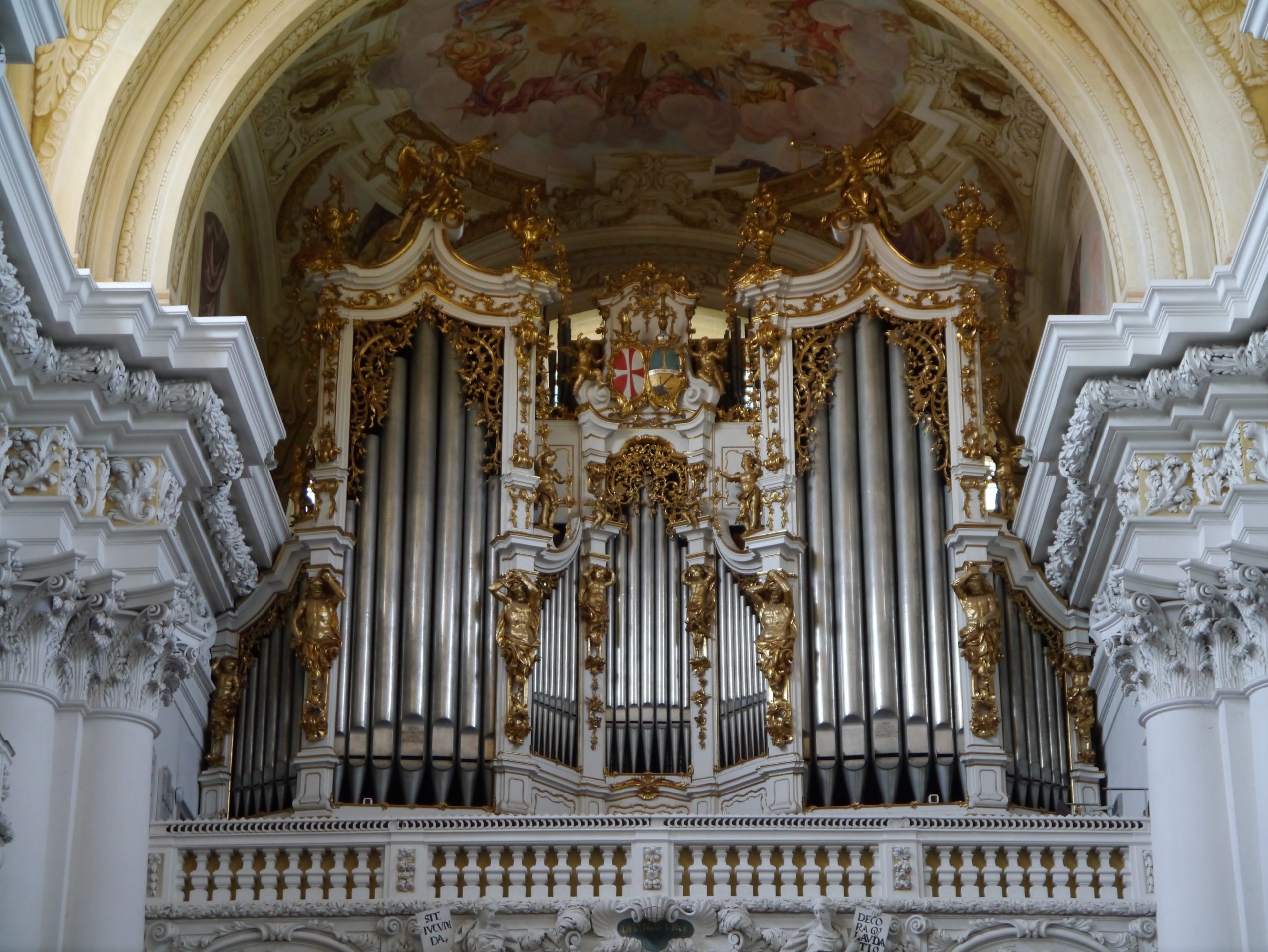
Anton Bruckner (1824-1896). The “Bruckner Organ” in Sankt Florian.
Study period
In 1855, Bruckner, aspiring to become a student of the famous Vienna music theorist Simon Sechter, showed the master his Missa solemnis (WAB 29), written a year earlier, and was accepted. The education, which included skills in music theory and counterpoint among others, took place mostly via correspondence, but also included long in-person sessions in Vienna. Sechter’s teaching would have a profound influence on Bruckner. Later, when Bruckner began teaching music himself, he would base his curriculum on Sechter’s book Die Grundsätze der musikalischen Komposition (Leipzig 1853/54).
In 1861, Bruckner studied further with Otto Kitzler, who was nine years younger than him and who introduced him to the music of Richard Wagner, which Bruckner studied extensively from 1863 onwards.
Bruckner considered the earliest orchestral works (the three orchestral pieces, the March in D minor and the Overture in G minor, which he composed in 1862-1863) mere school exercises, done under the supervision of Otto Kitzler. He continued his studies to the age of 40. Broad fame and acceptance did not come until he was over 60 (after the premiere of his Seventh Symphony in 1884). A devout Catholic who loved to drink beer, Bruckner was out of step with his contemporaries. In 1861 he had already made the acquaintance of Franz Liszt who, like Bruckner, had a strong, Catholic religious faith and who first and foremost was a harmonic innovator, initiating the new German school together with Wagner.
In May 1861 he made his concert debut, as both composer and conductor of his Ave Maria, set in seven parts. Soon after Bruckner had ended his studies under Sechter and Kitzler, he wrote his first mature work, the Mass in D Minor. From 1861 to 1868, he alternated his time between Vienna and Sankt Florian. He wished to ensure he knew how to make his music modern, but he also wanted to spend time in a more religious setting.
The Vienna period
In 1868, after Sechter had died, Bruckner hesitantly accepted Sechter’s post as a teacher of music theory at the Vienna Conservatory, during which time he concentrated most of his energy on writing symphonies. These symphonies, however, were poorly received, at times considered “wild” and “nonsensical”. His students at the Conservatory included Richard Robert.
Year 1880. Card received by Gustav Mahler (1860-1911) from Anton Bruckner (1824-1896). Unsigned card, with two lines of music: a fragment of the trio in the march in Franz von Suppe (1819-1895)‘s Faninitza, and the Valhalla theme from Richard Wagner (1813-1883)‘s Ring. References to the bible verses Mattew 24:15 and Mark 13:13.
Year 1880. Card received by Gustav Mahler (1860-1911) from Anton Bruckner (1824-1896). Unsigned card, with two lines of music: a fragment of the trio in the march in Franz von Suppe (1819-1895)‘s Faninitza, and the Valhalla theme from Richard Wagner (1813-1883)‘s Ring. References to the bible verses Mattew 24:15 and Mark 13:13.
He later accepted a post at the Vienna University in 1875, where he tried to make music theory a part of the curriculum. Overall, he was unhappy in Vienna, which was musically dominated by the critic Eduard Hanslick. At the time there was a feud between advocates of the music of Wagner and Brahms; by aligning himself with Wagner, Bruckner made an unintentional enemy out of Hanslick. However, he was not without supporters; Deutsche Zeitung’s music critic Theodor Helm (1843-1920), and famous conductors such as Arthur Nikisch and Franz Schalk constantly tried to bring his music to the public, and for this purpose proposed ‘improvements’ for making Bruckner’s music more acceptable to the public. While Bruckner allowed these changes, he also made sure in his will to bequeath his original scores to the Vienna National Library, confident of their musical validity.
07-04-1893, Year 1893. Letter received by Gustav Mahler (1860-1911) from Anton Bruckner (1824-1896). Thanks Mahler for his Good Friday (31-03-1893) performance of his Te Deum and Mass in D minor, and for his support against his critics.
07-04-1893, Year 1893. Letter received by Gustav Mahler (1860-1911) from Anton Bruckner (1824-1896). Thanks Mahler for his Good Friday (31-03-1893) performance of his Te Deum and Mass in D minor, and for his support against his critics.
07-04-1893, Year 1893. Letter received by Gustav Mahler (1860-1911) from Anton Bruckner (1824-1896). Thanks Mahler for his Good Friday (31-03-1893) performance of his Te Deum and Mass in D minor, and for his support against his critics.
In addition to his symphonies, Bruckner wrote masses, motets and other sacred choral works, and a few chamber works, including a string quintet. Unlike his romantic symphonies, some of Bruckner’s choral works are often conservative and contrapuntal in style; however, the Te Deum, Helgoland, Psalm 150 and at least one Mass demonstrate innovative and radical uses of chromaticism.
13-11-1893, Year 1893. Letter received by Gustav Mahler (1860-1911) from Anton Bruckner (1824-1896). Photostat. Hans Richter (1843-1916) has called him a fool for refusing to make further cuts.
13-11-1893, Year 1893. Letter received by Gustav Mahler (1860-1911) from Anton Bruckner (1824-1896). Photostat. Hans Richter (1843-1916) has called him a fool for refusing to make further cuts.
Biographers generally characterize Bruckner as a “simple” provincial man, and many biographers have complained that there is huge discrepancy between Bruckner’s life and his work. For example, Karl Grebe said: “his life doesn’t tell anything about his work, and his work doesn’t tell anything about his life, that’s the uncomfortable fact any biography must start from.”
Anecdotes abound as to Bruckner’s dogged pursuit of his chosen craft and his humble acceptance of the fame that eventually came his way. Once, after a rehearsal of his Fourth Symphony in 1881, the well-meaning Bruckner tipped the conductor Hans Richter: “When the symphony was over,” Richter related, “Bruckner came to me, his face beaming with enthusiasm and joy. I felt him press a coin into my hand. ‘Take this’ he said, ‘and drink a glass of beer to my health.’” Richter, of course, accepted the coin, a Maria Theresa thaler, and wore it on his watch-chain ever after.
Bruckner was a renowned organist in his day, impressing audiences in France in 1869, and England in 1871, giving six recitals on a new Henry Willis organ at Royal Albert Hall in London and five more at the Crystal Palace. Though he wrote no major works for the organ, his improvisation sessions sometimes yielded ideas for the symphonies. He taught organ performance at the Conservatory; among his students were Hans Rott and Franz Schmidt. Gustav Mahler, who called Bruckner his “forerunner”, attended the conservatory at this time (Walter n.d.).
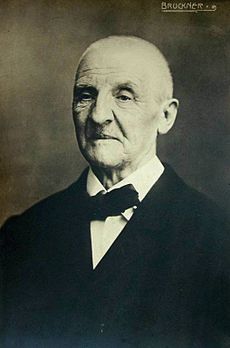
Anton Bruckner (1824-1896) in Year 1894.
Bruckner was a lifelong bachelor who made numerous unsuccessful marriage proposals to teenage girls. One such was the daughter of a friend, called Louise; in his grief he is believed to have written the cantata “Entsagen” (Renunciation). His affection for teenage girls led to an accusation of impropriety where he taught music, and while he was exonerated, he decided to concentrate on teaching boys afterwards. His calendar for 1874 details the names of girls who appealed to him, and the list of such girls in all his diaries was very long. In 1880 he fell for a 17-year-old peasant girl in the cast of the Oberammergau Passion Play.
His interest in young girls seems to have been motivated by his fear of sin; he believed that (unlike older women) he could be certain that he was marrying a virgin. His unsuccessful proposals to teenagers continued when he was past his 70th birthday; one prospect, Berlin hotel chambermaid Ida Buhz, came near to marrying him but broke off the engagement when she refused to convert to Catholicism. He suffered from periodic attacks of depression, with his numerous failed attempts to find a female companion only adding to his unhappiness. It has been suggested that Bruckner himself died a virgin.
In July 1886, the Emperor decorated him with the Order of Franz Joseph. He most likely retired from his position at the University of Vienna in 1892, at the age of 68. He wrote a great deal of music that he used to help teach his students.

Anton Bruckner (1824-1896) wearing the Order of Franz Joseph (portrait by Josef Büche, Year 1896).
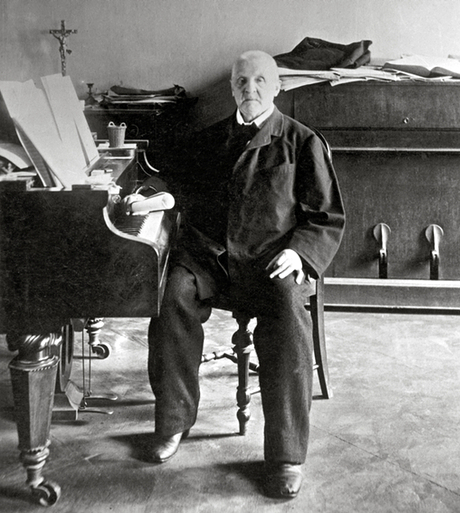
Anton Bruckner (1824-1896) in Year 1896.
Bruckner died in Vienna in 1896 at the age of 72. He is buried in the crypt of the monastery church at Sankt Florian, immediately below his favorite organ. He had always had a morbid fascination with death and dead bodies, and left explicit instructions regarding the embalming of his corpse.
Bruckner died 11-10-1896 at 16:00 clock, according to the death book, a heart valve defect. His mortal remains were embalmed according to his will. In the party written in the name of his siblings Rosalia and Ignaz, can be read that on 14-10-1896 he was transferred to the Karlskirche by the funeral home (IIIrd district, Heugasse Nr. 3, Upper Belvedere), which was re-blessed and buried on 15-10-1896 in the monastery basilica of St. Florian. Bruckner’s sarcophagus, which is placed below the organ, bears the inscription “For eternity I will not shame”, the final line of the Tedeum.
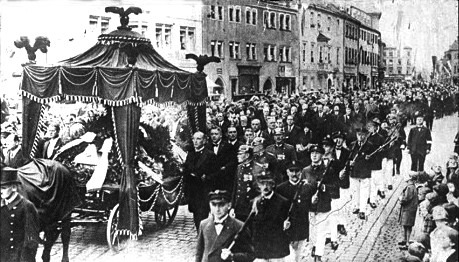
Funeral Anton Bruckner (1824-1896), Year 1896.
Compositions
Sometimes Bruckner’s works are referred to by WAB numbers, from the Werkverzeichnis Anton Bruckner, a catalogue of Bruckner’s works edited by Renate Grasberger. The revision issue has generated controversy. A common explanation for the multiple versions is that Bruckner was willing to revise his work on the basis of harsh, uninformed criticism from his colleagues. “The result of such advice was to awaken immediately all the insecurity in the non-musical part of Bruckner’s personality,” musicologist Deryck Cooke writes. “Lacking all self-assurance in such matters, he felt obliged to bow to the opinions of his friends, ‘the experts,’ to permit … revisions and even to help make them in some cases.”
This explanation was widely accepted when it was championed by Bruckner scholar Robert Haas, who was the chief editor of the first critical editions of Bruckner’s works published by the International Bruckner Society; it continues to be found in the majority of program notes and biographical sketches concerning Bruckner.
Haas’s work was endorsed by the Nazis and so fell out of favour after the war as the Allies enforced denazification. Haas’s rival Leopold Nowak was appointed to produce a whole new critical edition of Bruckner’s works. He and others such as Benjamin Korstvedt and conductor Leon Botstein argued that Haas’s explanation is at best idle speculation, at worst a shady justification of Haas’s own editorial decisions. Also, it has been pointed out that Bruckner often started work on a symphony just days after finishing the one before.
As Cooke writes, “In spite of continued opposition and criticism, and many well-meaning exhortations to caution from his friends, he looked neither to right nor left, but simply got down to work on the next symphony.” The matter of Bruckner’s authentic texts and the reasons for his changes to them remains politicised and uncomfortable.
Symphonies
“Bruckner expanded the concept of the symphonic form in ways that have never been witnessed before or since. … When listening to a Bruckner symphony, one encounters some of the most complex symphonic writing ever created. As scholars study Bruckner’s scores they continue to revel in the complexity of Bruckner’s creative logic.”
Style
Bruckner’s symphonies are all in four movements (though he was unable to complete the finale of the Ninth), starting with a modified sonata allegro form, a slow movement in ABA’B’A’’ form (except in the Study Symphony, the First and the Sixth), a scherzo in 3/4 time, and a modified sonata allegro form finale. (In the Eighth, Ninth, and the first version of the Second, the slow movements and scherzo are reversed. The revised version of the Fourth features a scherzo – the “Hunt scherzo” – in which the outer sections are in 2/4 meter, not the customary 3/4.) There is a marked preference for the use of consistent four-bar periods. They are scored for a fairly standard orchestra of woodwinds in pairs, four horns, two or three trumpets, three trombones, tuba (from the second version of the Fourth), timpani and strings.
The later symphonies increase this complement, but not by much. Notable is the use of Wagner tubas in his last three symphonies. Only the Eighth has harp, and percussion besides timpani (though legend has it the Seventh is supposed to have a cymbal clash at the exact moment Wagner died). With the exception of Symphony No. 4, none of Bruckner’s symphonies have subtitles, and most of their nicknames did not originate with the composer. Trademarks of Bruckner’s works are powerful codas and grand finales, as well as the frequent use of unison passages and orchestral tutti. His style of orchestral writing was criticized by his Viennese contemporaries, but by the middle of the twentieth century musicologists recognized that Bruckner’s orchestration was modeled after the sound of his primary instrument, the pipe organ, i.e. alternating between two groups of instruments, as when changing from one manual of the organ to another.
Nicholas Temperley writes in the New Grove Dictionary of Music and Musicians (1980) that Bruckner
alone succeeded in creating a new school of symphonic writing…. Some have classified him as a conservative, some as a radical. Really he was neither, or alternatively was a fusion of both…. [H]is music, though Wagnerian in its orchestration and in its huge rising and falling periods, patently has its roots in older styles. Bruckner took Beethoven’s Ninth Symphony as his starting-point…. The introduction to the first movement, beginning mysteriously and climbing slowly with fragments of the first theme to the gigantic full statement of that theme, was taken over by Bruckner; so was the awe-inspiring coda of the first movement. The scherzo and slow movement, with their alternation of melodies, are models for Bruckner’s spacious middle movements, while the finale with a grand culminating hymn is a feature of almost every Bruckner symphony.
Bruckner is the first composer since Schubert about whom it is possible to make such generalizations. His symphonies deliberately followed a pattern, each one building on the achievements of its predecessors…. His melodic and harmonic style changed little, and it had as much of Schubert in it as of Wagner…. His technique in the development and transformation of themes, learnt from Beethoven, Liszt and Wagner, was unsurpassed, and he was almost the equal of Brahms in the art of melodic variation.
Cooke adds, also in the New Grove,
Despite its general debt to Beethoven and Wagner, the “Bruckner Symphony” is a unique conception, not only because of the individuality of its spirit and its materials, but even more because of the absolute originality of its formal processes. At first, these processes seemed so strange and unprecedented that they were taken as evidence of sheer incompetence…. Now it is recognized that Bruckner’s unorthodox structural methods were inevitable…. Bruckner created a new and monumental type of symphonic organism, which abjured the tense, dynamic continuity of Beethoven, and the broad, fluid continuity of Wagner, in order to express something profoundly different from either composer, something elemental and metaphysical.
In a concert review, Bernard Holland described parts of the first movements of Bruckner’s sixth and seventh symphonies as follows: “There is the same slow, broad introduction, the drawn-out climaxes that grow, pull back and then grow some more – a sort of musical coitus interruptus.”
In the 2001 Second Edition of the New Grove, Mark Evan Bonds called the Bruckner symphonies “monumental in scope and design, combining lyricism with an inherently polyphonic design…. Bruckner favored an approach to large-scale form that relied more on large-scale thematic and harmonic juxtaposition. Over the course of his output, one senses an ever-increasing interest in cyclic integration that culminates in his masterpiece, the Symphony No. 8 in C minor, a work whose final page integrates the main themes of all four movements simultaneously.”
Works
Otto Kitzler, Bruckner’s last composition teacher, set him three final tasks as the climax of his studies: a choral work (Psalm 112), an overture (the Overture in G minor), and a symphony. The last, completed in 1863, was then Bruckner’s Study Symphony in F minor. Bruckner later rejected this work, but he did not destroy it. While it certainly reminds one of earlier composers such as Robert Schumann, it undeniably also bears the hallmarks of the later Bruckner style. Kitzler simply commented that the work was “not very inspired”. It was first performed in 1924 and not published until 1973 and is occasionally listed as “Symphony No. 00”.
Bruckner’s Symphony No. 1 in C minor (sometimes called by Bruckner “das kecke Beserl”, roughly translated as “the saucy maid”) was completed in 1866, but the original text of this symphony was not reconstructed until 1998. Instead, it is commonly known in two versions, the so-called Linz Version which is based mainly on rhythmical revisions made in 1877, and the completely revised Vienna Version of 1891, which begins to reveal his mature style, e.g. Symphony No. 8.
Next was the “nullified” Symphony in D minor of 1869, the so-called “Symphony No. 0”, a work which was so harshly criticized that Bruckner retracted it completely, and it was not performed at all during his lifetime, hence the nickname of this symphony.
His next attempt was a sketch of the first movement to a Symphony in B-flat major, but he did no further work on it afterwards. There is a single, recent commercially available recording of this sketch: Ricardo Luna, Bruckner unknown, CD Preiser Records PR 91250, 2013.
The Symphony No. 2 in C minor of 1872 was revised in 1873, 1876, 1877 and 1892. It is sometimes called the Symphony of Pauses for its dramatic use of whole-orchestra rests, which accentuate the form of the piece. In the Carragan edition of the 1872 version, the Scherzo is placed second and the Adagio third. It is in the same key as No. 1.
Bruckner presented his Symphony No. 3 in D minor, written in 1873, to Wagner along with the Second, asking which of them he might dedicate to him. Wagner chose the Third, and Bruckner sent him a fair copy soon after, which is why the original version of the Wagner Symphony is preserved so well despite revisions in 1874, 1876, 1877 and 1888–9. One factor that helped Wagner choose which symphony to accept the dedication of was that the Third contains quotations from Wagner’s music dramas, such as Die Walküre and Lohengrin. Most of these quotations were taken out in the revised versions.
Bruckner’s first great success was his Symphony No. 4 in E flat major, more commonly known as the Romantic Symphony, the only epithet applied to a symphony by the composer himself. The 1874 version has been seldom played; success came in 1878 but only after major revisions, including a completely new scherzo and finale, and again in 1880–1, once again with a completely rewritten finale. This version was premiered in 1881 (under the conductor Hans Richter). Bruckner made more minor revisions of this symphony in 1886–8.
Bruckner’s Symphony No. 5 in B flat major crowns his most productive era of symphony-writing, finished at the beginning of 1876. Until recently we knew only the thoroughly revised version of 1878. In 2008 the original concepts of this symphony were edited and performed by Akira Naito with the Tokyo New City Orchestra. Many consider this symphony to be Bruckner’s lifetime masterpiece in the area of counterpoint. For example, the Finale is a combined fugue and sonata form movement: the first theme (characterized by the downward leap of an octave) appears in the exposition as a four-part fugue in the strings and the concluding theme of the exposition is presented first as a chorale in the brass, then as a four-part fugue in the development, and culminating in a double fugue with the first theme at the recapitulation; additionally, the coda combines not only these two themes but also the main theme of the first movement. Bruckner never heard it played by an orchestra.
Symphony No. 6 in A major, written in 1879-1881, is an oft-neglected work; whereas the Bruckner rhythm (two quarters plus a quarter triplet or vice versa) is an important part of his previous symphonies, it pervades this work, particularly in the first movement, making it particularly difficult to perform.
Symphony No. 7 in E major was the most beloved of Bruckner’s symphonies with audiences of the time, and is still popular. It was written 1881–1883 and revised in 1885. During the time that Bruckner began work on this symphony, he was aware that Wagner’s death was imminent, and so the Adagio is slow mournful music for Wagner (the climax of the movement comes at rehearsal letter W), and for the first time in Bruckner’s oeuvre, Wagner tubas are included in the orchestra.
Bruckner began composition of his Symphony No. 8 in C minor in 1884. In 1887 Bruckner sent the work to Hermann Levi (1839-1900), the conductor who had led his Seventh to great success. Hermann Levi (1839-1900), who had said Bruckner’s Seventh Symphony was the greatest symphony written after Beethoven, believed that the Eighth was a confusing jumble. Devastated by Hermann Levi (1839-1900)‘s assessment, Bruckner revised the work, sometimes with the aid of Franz Schalk, and completed this new version in 1890. Cooke writes that “Bruckner not only recomposed [the Eighth]… but greatly improved it in a number of ways…. This is the one symphony that Bruckner did not fully achieve in his first definite version, to which there can be no question of going back.”
The final accomplishment of Bruckner’s life was to be his Symphony No. 9 in D minor which he started in August 1887, and which he dedicated “To God the Beloved.” The first three movements were completed by the end of 1894, the Adagio alone taking 18 months to complete. Work was delayed by the composer’s poor health and by his compulsion to revise his early symphonies, and by the time of his death in 1896 he had not finished the last movement. The first three movements remained unperformed until their premiere in Vienna (in Ferdinand Löwe’s version) on 11 February 1903.
Bruckner suggested using his Te Deum as a Finale, which would complete the homage to Beethoven’s Ninth symphony (also in D minor). The problem was that the Te Deum is in C major, while the Ninth Symphony is in D minor, and, although Bruckner began sketching a transition from the Adagio key of E major to the triumphant key of C major, he did not pursue the idea. There have been several attempts to complete these sketches and prepare them for performance, as well as completions of his later sketches for an instrumental Finale, but only the first three movements of the symphony are usually performed.
The Bruckner Problem
“The Bruckner Problem” is a term that refers to the difficulties and complications resulting from the numerous contrasting versions and editions that exist for most of the symphonies. The term gained currency following the publication (in 1969) of an article dealing with the subject, “The Bruckner Problem Simplified,” by musicologist Deryck Cooke, which brought the issue to the attention of English-speaking musicians.
The first versions of the Bruckner’s symphonies often presented an instrumental, contrapuntal and rhythmic complexity (Brucknerian rhythm “2 + 3”, use of quintolets), the originality of which has not been understood and considered unperformable by the musicians. In order to make them “performable”, the symphonies, except Symphonies No. 6 and No. 7, have been revised several times. Consequently there are several versions and editions, mainly of Symphonies 3, 4 and 8, which have been deeply emended by Bruckner’s friends and associates, and it is not always possible to tell whether the emendations had Bruckner’s direct authorization.
Looking for authentic versions of the symphonies, Robert Haas produced during the 1930s a first critical edition of Bruckner’s works based on the original scores. After World War II other scholars (Leopold Nowak, William Carragan, Benjamin-Gunnar Cohrs et al.) carried on with this work.
Sacred choral work
Bruckner was a devoutly religious man, and composed numerous sacred works. He wrote a Te Deum, settings of five Psalms (including Psalm 150 in the 1890s), a Festive cantata, a Magnificat, about forty motets (among them eight settings of Tantum ergo, and three settings of both Christus factus est pro nobis and Ave Maria), and at least seven Masses. The three early masses, composed between 1842 and 1844, were short Austrian Landmessen for use in local churches and did not always set all the numbers of the ordinary. His Requiem in D minor of 1849 is the earliest work Bruckner himself considered worthy of preservation. It shows the clear influence of Mozart’s Requiem (also in D minor) and similar works of Michael Haydn. The seldom performed Missa solemnis, composed in 1854 for Friedrich Mayer’s elevation, was the last major work Bruckner composed before he started to study with Simon Sechter.
The three Masses Bruckner wrote in the 1860s and revised later on in his life are more often performed. The Masses numbered 1 in D minor and 3 in F minor are for solo singers, mixed choir, organ ad libitum and orchestra, while No. 2 in E minor is for mixed choir and a small group of wind instruments, and was written in an attempt to meet the Cecilians halfway. The Cecilians wanted to rid church music of instruments entirely. No. 3 was clearly meant for concert, rather than liturgical performance, and it is the only one of his Masses in which he set the first line of the Gloria, “Gloria in excelsis Deo”, and of the Credo, “Credo in unum Deum”, to music. In concert performances of the other Masses, these lines are intoned by a tenor soloist in the way a priest would, with a line of plainsong.
Secular vocal works

“Anton Bruckner arrives in Heaven”. Bruckner is greeted by (from left to right): Liszt, Wagner, Schubert, Schumann, Weber, Mozart, Beethoven, Gluck, Haydn, Handel, Bach. (Silhouette drawing by Otto Böhler).
As a young man Bruckner sang in men’s choirs and wrote music for them. Bruckner’s secular choral music was mostly written for choral societies. The texts are always in German. Some of these works were written specifically for private occasions such as weddings, funerals, birthdays or name-days, many of these being dedicated to friends and acquaintances of the composer. This music is rarely performed. Biographer Derek Watson characterizes the pieces for men’s choir as being “of little concern to the non-German listener”. Of about 30 such pieces, a most unusual and evocative composition is the choral Abendzauber (1878) for tenor, yodelers and four alpine horns. This work, which was never performed in Bruckner’s lifetime, can be heard on YouTube.
Bruckner composed also 20 lieder, of which only a few have been issued. The lieder, which Bruckner composed in 1861-1862 during his tuition by Otto Kitzler, have not been edited or WAB classified. The last-known owner of this important source (Ms. Kress, Munich) deceased, apparently without descendants. The present location of the Studienbuch is unknown; it may be lost. The Austrian National Library holds a photocopy, possibly the only surviving source of it (PhA 2178), but does not give permission for publication.
Bruckner composed also five name-day cantatas, as well as two patriotic cantatas, Germanenzug and Helgoland, on texts by August Silberstein. Germanenzug (WAB 70), composed in 1863–1864, was Bruckner’s first published work. Helgoland] (WAB 71), composed in 1893, was the only secular vocal work Bruckner thought worthy enough to bequeath to the Vienna National Library.https://mahlerfoundation.org/mahler/contemporaries/anton-bruckner/

De Romantiek I
Anton Bruckner (1824 – 1896)
Sommige muziek is zo verheven, schoon en edel, dat het bespreken ervan al een ontheiliging bewerkt. Iedere omschrijving gedoemd is te mislukken. Iedere verhandeling, onbevredigend blijkt. Dat geldt zeker voor de muziek van Anton Bruckner. Dit artikel is volledig aan hem gewijd, omdat hij een totaal eigen plaats inneemt in de 19de eeuwse muziek en zich volledig aan de periferie van de romantiek – en alles wat daarmee verband houdt -, bevond. De volledige concentratie op de symfonie als vorm en kunstwerk kon hij alleen volhouden, door zich vrijwel altijd afzijdig te houden van de literaire en filosofische stromingen, maar ook van zijn collega’s uit de beeldende kunst. Een andere reden is de vaste overtuiging dat in Bruckners kunst het fenomeen symfonie, de absolute bekroning vindt. Daarmee is overigens allerminst gezegd dat een Beethoven, Schubert of Mozart symfonie minder gaaf en bevredigend is.
Ontstaansgeschiedenis van de symfonie
Het blijkt dat Haydn ten onrechte de geestelijke vader genoemd wordt van de symfonie. Uit publicaties blijkt dat hij de verworvenheden van diverse voorgangers ‘slechts’ heeft toegepast. Diverse componisten uit verschillende plaatsen zijn verantwoordelijk voor de geboorte van het vormschema symfonie. Mannheim heeft naam met Johann Stamitz (1717 – 1757), maar evenzeer de noord Duitse school met CPE. Bach (1714 – 1788) en broer Wilhelm Friedemann (1710 – 1784), de Weense school met George Matthias Monn (1717 – 1750) en de Italiaanse school met Giovanni Battista Sammartini (1701 – 1775).
De verworvenheden van deze grote pioniers zijn uiteindelijk met succes door Haydn en Mozart toegepast, gecultiveerd en verder bewerkt. Via harmonische uitbreidingen door Beethoven en Berlioz, zou de lijn der ontwikkeling verder gaan om in Bruckner de meester te vinden die de symfonie een ingrijpende gedaantewisseling zou laten ondergaan, zonder de essentie aan te tasten. Hij is er in geslaagd de symfonie als vorm in overeenstemming te brengen met de veranderde geestelijke positie in de Romantiek. Een voorbeeld is de toevoeging van een derde thema of themagroep. Pas na hem zou de symfonie een langzame dood sterven.
De Symfonieën van Bruckner
De grote fout die men wel maakt is dat men de Bruckner symfonieën vergelijkt met die van de grote klassieke meesters voor hem; zoals Beethoven. Alleen al vanuit psychologisch standpunt is de kunst van deze grootse romanticus anders dan de klassieke reus Beethoven, die het mensenleed en de broederliefde bezingt. Ook is Bruckner niet de held van zijn eigen symfonieën, zoals we dat van Beethoven veronderstellen. Zijn muziek is – zij het op geheel eigen wijze – even objectief en boven persoonlijk als die van Bach.
Ook de zelfbewustheid waarmee een Wagner of Beethoven en zijn eigen tijdgenoten componeerde, is hem vreemd en ik ben geneigd te denken dat hij zich niet of nauwelijks bewust was hoe belangrijk zijn bijdrage aan de symfonische kunst wel was. Terwijl een Berlioz of Beethoven, dat wel degelijk wisten. De mooiste typering over de persoon Bruckner is wellicht die door van Hengel in diens Bruckner biografie: half imperator, half heilige. Het is overigens altijd interessant hoe de groten der aarde over elkaar praten. Johannes Brahms moet eens tegen Bruckner gezegd hebben: “ik begrijp helemaal niets van uw muziek”, waarop Bruckner repliceerde: “dat is toevallig, laat ik nu precies hetzelfde hebben”.
Er zijn er geweest die Bruckner als een Wagner epigoon hebben betiteld. Het is waar dat Bruckner Wagner aanbad en in hem een harmonische bevrijder zag. Een aantal verworvenheden van Wagner heeft Bruckner ook wel gebruikt. Maar meer ook niet en dan nog geheel op zijn eigen wijze. Alleen al het feit dat Bruckner zich niets aantrok van zijn held Wagner, om gewoon symfonieën te blijven schrijven zegt genoeg (zie vorig artikel). De opmerking door sommigen in het verleden dat Bruckner’s muziek slechts symfonische uitingen van Wagners’ opera’s zijn, is volslagen belachelijk.
Vergelijking met een Beethoven symfonie bijvoorbeeld, leert dat Bruckner het orkest significant heeft uitgebreid: een derde trompet, een bastuba, een grotere houtsectie, een harp (in de achtste) en uiteraard de zgn. Wagner tuba’s in de laatste drie symfonieën, waardoor de orkestklank aanzienlijk donkerder wordt gekleurd. Deze uitbreiding in het koper en hout, heeft natuurlijk consequenties voor de orkestklankbalans. Omdat de strijkers tegenover een massaler blazercomplex staan dan in de klassieke symfonie, moet hun aantal ook uitgebreid worden.
Zelden hebben we in de symfonische literatuur gezien dat de tweede violen en alten uit hun ondergeschikte plaats in het orkest worden gehaald en een eigen rol krijgen; en veelal zelfs een leidende functie.
Een ander opvallend en buitengewoon interessant aspect is dat de tweede violen rechts (voor de concertbezoeker) opgesteld dienen te worden, wat consequenties voor de totaalklank heeft. Omdat nu bij deze opstelling de F-gaten op het bovenblad der tweede violen meer naar achteren stralen, krijgen ze zodoende een meer omfloerste, vage mystieke klank dan de eerste violen. De laatste keer dat ik Martin Sieghart zag met het Gelders orkest in de Vereeniging in Nijmegen, had hij de tweede violen ook op rechts geplaatst en de bassen links achterin. Ik weet niet of hij dat allang doet, maar het klonk inderdaad anders dan anders.
Er zijn plekken in Bruckners muziek aan te wijzen waarin een celli thema wordt ondersteund door de tweede violen, waardoor het haast lijkt of een melodie zich met zijn eigen schaduw laat horen. Deze geheimzinnige klank is niet toevallig maar typerend voor de levensvisie van deze meester, die het eeuwige natuurmysterie verklankt, maar ook het mysterie tussen schepper en schepsel.
Ook bij het koper zien we een totaal andere behandeling dan voorheen. Niet alleen is er meer zelfstandigheid voor deze groep, maar dikwijls een ook leidende positie. Dat Bruckner het koper apart noteerde, zegt genoeg.
Eenmaal de speurtocht in zijn kunst begonnen, stuiten we op onbeschrijfelijke muzikale invallen, stemmenweefsels, klankcombinaties en vlechtwerk van melodieën waardoor wij vaak in verwarring zijn of het nu een melodie of een begeleiding betreft. Zijn muziek is nooit teveel en nooit te weinig. Luister hoe zijn muziek voortdurend spant en ontspant. Kortom: het mechanisme waarvoor de Europeaan zo gevoelig is.
Hij heeft – zijn studie symfonie in F meegerekend – 11 symfonieën, diverse koorwerken, een Te Deum en een prachtig strijkkwintet geschreven. Daar komt nog bij dat hij de meeste symfonieën op latere leeftijd nog grondig heeft herzien. Ook hierin is Bruckner uniek. En met herzien, bedoelen we niet hier en daar even wat bijschaven of polijsten. Integendeel, dit zijn ingrijpende en dus tijdrovende herzieningen geweest. Als er ergens iets verandert, dan moet dat ook op andere plekken gebeuren ter wille van de balans in de structuur. De achtste is hier wellicht het meest in het oog springende voorbeeld van. Wat een verschil met de tweede en meest uitgevoerde versie! Zo beschouwd, heeft hij het aantal symfonieën bijna verdubbeld. Uiteindelijk is hij daardoor tijd tekort gekomen om zijn geweldige 9de symfonie, af te maken.
De cycli
Er zijn in de loop der tijd veel cycli op plaat uitgebracht met beroemde dirigenten, waaronder de Brucknerianen, Haitink, Jochum, von Karajan en Walter. De complete set door von Karajan uit de jaren 70 kan men als de absolute ruggengraat beschouwen. Uit deze cyclus blijkt von Karajans meesterlijke inzicht in de structuur van de Bruckner symfonie. Vooral de derde klinkt meesterlijk, maar ook de achtste en negende zijn bij hem in goede handen. Prettig is dat deze uitvoeringen gemakkelijk in het tweede hands circuit te krijgen zijn, behalve dan de opnames uit het digitale tijdperk. Die zijn wat lastiger. Overigens wordt slechts zelden de complete set aangeboden op e-Bay. Vreemd is wel dat von Karajan nooit de nulde heeft opgenomen.
De Philips set door Haitink uit de jaren 60 en 70 is een interessante. Hoewel qua tempi hier en daar aan de snelle kant, geeft de jonge Haitink wel de wetenschappelijk verantwoorde versies van de tweede en derde, maar in het slot van het eerste deel van de negende is hij wat eigenzinnig met de paukenslagfiguur. Dat doet hij ook in zijn opname uit het begin jaren 80 en is daardoor dan wel weer consequent.
De DG set door Jochum is enigszins teleurstellend, maar zijn EMI cyclus is nuttig als aanvulling. Die worden soms als losse uitgaven her en der aangeboden en klinken bijzonder goed.

Dan de set door Inbal op Teldec Telefunken, die van alle symfonieën de oorspronkelijke versies geeft en daarom buitengewoon interessant is. Onbegrijpelijk dat de grote Bruckner interpreten nooit de eerste versie van de achtste hebben opgenomen. Voor deze versie is men op de plaat dus aangewezen op Inbal met de Frankfurters.
De losse uitgaven
Welke set men ook kiest het is altijd zinvol, dirigenten te beluisteren die slechts enkele symfonieën van Bruckner hebben opgenomen. Onder de losse uitvoeringen, vinden we voor de achtste een uitmuntende Giulini met de Weners op DG, die in veel opzichten mijn voorkeur heeft. Ook zijn negende uit hetzelfde huis is fantastisch. Het lijkt wanneer Giulini een Bruckner symfonie dirigeert, alles op natuurlijke wijze ademt. Helaas is de 9e alleen op CD beschikbaar, maar vinyl liefhebbers kunnen gerust hun toevlucht nemen tot de EMI uitgave met de Chicago Symfonie Orchestra uit eind jaren 70.
Von Karajan heeft de negende al een keer eerder opgenomen voor DG halverwege de jaren 60, die door veel liefhebbers wordt geprezen. Persoonlijk vind ik het een grote teleurstelling: veel te snel gekozen tempi. Ook de achtste die hij eind jaren 50 voor EMI heeft opgenomen, vind ik geen onverdeeld succes.
De Negende door Dohnanyi op Decca dient vermeden te worden, maar de zesde door Solti uit hetzelfde huis is een welkome aanvulling. Ook die met Klemperer op EMI heeft veel lauweren geoogst en kan als de norm worden beschouwd. De uitvoeringen van Gunther Wand met de Kölners worden regelmatig op e-Bay aangeboden en zijn ook zeer de moeite waard.
Volgende maand zullen we Bruckners tijdgenoot Brahms en de generatie daarvoor met Schumann – die Brahms heeft beïnvloed – en Mendelssohn bespreken. Een behoudende stroming die het waardevolle erfgoed van de traditie bewaakte en kampte met de 19de eeuwse problemen van vorm en inhoud. http://www.audioenmuziek.nl/muziekgeschiedenis/de-romantiek-i-anton-bruckner/
Sex, death and dissonance: the strange, obsessive world of Anton Bruckner
There’s no doubt Anton Bruckner was an oddball, a man with an unhealthy interest in dead bodies and teenage girls. But the composer’s obsessions and terrors also gave us some astonishing music

‘A death-obsessed maniac’ … a portrait of Anton Bruckner from 1893.
Photograph: Imagno/Getty ImagesTom ServiceTue 1 Apr 2014 18.00 BST
A credulous yokel who propositioned girls half his age. A death-obsessed ghoul who kept a photo of his mother’s corpse. A cranky, backwards-looking obsessive. The composer of some of the 19th century’s greatest, grandest and most ambitious symphonies. Anton Bruckner was all of these things. One thing he wasn’t, however, was a writer of beautiful music offering serene escapism.
Mariss Jansons and Amsterdam’s Concertgebouw, who visit London’s Barbican this week to perform three Bruckner symphonies, will unleash sounds of orchestral ugliness and visions of existential disturbance that will – that should – have you quaking in your seats.
These works – Bruckner’s 4th, 7th and his unfinished 9th – opened up a new musical and spiritual terrain. The titanic shocks that these paradoxical pieces delivered were achieved by a man who worshipped the gods of musical conservatism at a time when the rules of composition were being dismantled by the likes of Gustav Mahler and Richard Strauss. Bruckner, by contrast, spent his life exploring musical principles that had been laid down centuries earlier – the laws of counterpoint, the way one musical voice interacts with another – which marked him out as a cranky weirdo in the context of the progressive artistic and intellectual scene of late 19th-century Vienna.
Vienna wasn’t Bruckner’s hometown. Born in the village of Ansfelden, he trained in St Florian, a monastery town that he didn’t properly leave until his middle age, having spent his youth in a self-annihilating study of musical arcana and hours of lonely training in order to become one of the world’s greatest organists. It was only in his 40s in Vienna that Bruckner felt confident enough to embark on the symphonic project that would sustain the rest of his musical life. But in doing so, he had to face the wrath of his critics, who called him everything from “a drunkard” to the composer of “symphonic boa-constrictors” (that one was Brahms). He also had to put up with caricatures of him as a devoutly, credulously Catholic country bumpkin who propositioned teenage girls in his old age, and who once tipped a conductor with cash for getting through a rehearsal of one of his symphonies.
Actually, both of those anecdotes are all too true. And as John Butt, professor of music at Glasgow University and a Bruckner devotee, told me, Bruckner really was – well, a bit of an oddball. In his diaries, he kept lists of the girls he fancied (usually in their late teens), he had a mania for counting the bricks and windows of buildings, and for counting the numbers of bars in his gargantuan orchestral scores, making sure their proportions were statistically correct. And there were even stranger sides to this kind of behaviour: when his mother died, Bruckner commissioned a photograph of her on her death bed and kept it in his teaching room. He had no image of his mother when she was alive, just this grotesque-seeming token of her death staring out at him as an unsettling memento mori. Butt also recalls accounts of Bruckner having “fingered and kissed the skulls of Beethoven and Schubert” when their corpses were exhumed and moved to a different cemetery; that Bruckner had requested permission to see the skull of a dead cousin (he was refused), and also that of the Emperor Maximilian, whose body was returned to Vienna after his execution in Mexico in 1867.

Bruckner: death-obsessed maniac. Well, partly. But as Butt says, “in the way that some obsessives don’t get anywhere in life, others get there in a very quirky way”. Bruckner’s peculiar brand of musical obsessiveness produced visions of grandeur that are at once ancient and modern. You hear that in the opening of the 4th symphony’s final, fourth movement – a chilling, dehumanised orchestral landscape in sound; in the emotional desolation of the 7th symphony’s slow movement, a tribute to the recently dead Wagner; and throughout the three completed movements of the 9th.
For me, this is Bruckner’s boldest compositional achievement. The symphony is the only one of his that’s explicitly dedicated to God. In a sense all of Bruckner’s music is a tribute to his devout faith, but the 9th dares something darker, more doubting, more apocalyptic, and more ear-shatteringly aggressive and even deliberately ugly than he had attempted before. The massively loud and dissonant orchestral pile-up of a chord near the end of the third movement is a vision of a despairing abyss that the quiet music that comes after it can’t possibly console. It’s as if Bruckner shrinks back from the vision his exquisitely arcane brain had led him to. That chord is the product of a passage of music that behaves entirely according to the laws of musical structure that the composer revered. Yet all that careful construction reveals something so strange, so shocking, and so disturbing – all the more so because the music has the irresistible power of a force of nature rather than a subjective, personal scream. It’s a moment that’s a transfiguration of all that obsessiveness. This isn’t Bruckner’s shout into the void, but the cosmos itself in pain. At least, that’s what it sounds like to me; in the Concertgebouw’s performance, it will confront the Barbican audience with violent sonic terrors. I hope that audience is ready. https://www.theguardian.com/music/2014/apr/01/sex-death-dissonance-anton-bruckner-concertgebouw-orchestra
Anton Bruckner – Symphony No.7 00:00 – I. Allegro moderato 19:26 – II. Adagio. Sehr feierlich und sehr langsam 41:11 – III. Scherzo (sehr schnell) 50:55 – IV. Finale. Bewegt, doch nicht zu schnell Wiener Symphoniker – Lovro von Matačić
Watch the full-length concert on takt1: https://smarturl.it/bruckner6takt1 Listen to Sir Simon Rattle’s first recording of Bruckner’s Sixth Symphony, out 25 October on LSO Live: https://smarturl.it/bruckner6 London Symphony Orchestra LSO
Anton Bruckner (* Sept. 4, 1824, Ansfelden/Linz; + Oct. 11, 1896, Vienna): Symphony No. 9 in D minor (1887 – 1896; unfinished – there exist only loose fragments for the fourth finale movement.) I. Feierlich, misterioso (starts at 0:37) II. Scherzo: Bewegt, lebhaft – Trio: Schnell (starts at 24:15) III. Adagio: Langsam, feierlich (starts at 34:39) Chicago Symphony Orchestra Sir Georg Solti, conductor Recorded at Orchestra Hall, Chicago, Sept., Oct. 1985 Released at Decca in 1986: http://www.amazon.com/Bruckner-Sympho… (Or order the complete Bruckner Symphonies, including Symphony No. “0”, with Sir Georg Solti and the Chicago Symphony Orchestra here: http://www.amazon.com/Bruckner-The-Sy…)
nton Bruckner – Symphony No. 7 in E major, WAB 107 0:00 Allegro moderato 21:05 Adagio: Sehr feierlich und sehr langsam 46:22 Scherzo: Sehr schnell – Trio: Etwas langsamer 57:06 Finale: Bewegt, doch nicht schnell Munich Philharmonic Orchestra conducted by Eugen Jochum Recorded live: 8 November 1979, Herkulessaal der Residenz München Konzertmitschnitt







